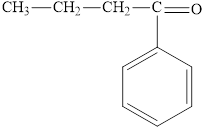
Concept explainers
(a)
Interpretation:The family (functional group) present in the given compound has to be written.
The given compound is,

Concept Introduction :

In carboxylic acid, the second oxygen atom is linked to a hydrogen atom.
The general formula for carboxylic acid is
(a)
Answer to Problem 72A
The given compound belongs to the family of carboxylic acid.
Explanation of Solution
The given compound is,

The compound 3-phenylpropanoic acid is acarboxylic acid.
In carboxylic acid, the second oxygen atom is bonded to a hydrogen atom.
The presence of carboxylic acid is identified by the presence of carboxyl group attached to the hydrocarbon chain.

The given compound belongs to the family of carboxylic acid.
(b)
Interpretation:The family (functional group) present in the given compound has to be written.
The given compound is,

Concept Introduction:

In ketones, the carbonyl group is bond to two carbon atoms. The general formula of a ketone is

In a ketone, the carbonyl group is not present at the end of the hydrocarbon chain.
(b)
Answer to Problem 72A
The given compound belongs to the family of ketones.
Explanation of Solution
(c)
Interpretation:The family (functional group) present in the given compound has to be written.
The given compound is,

Concept IntroductionEsters are carboxylic acid derivatives. The carbonyl group of the ester is polar. The general structure of ester is,

In an ester, the second oxygen atom is linked to another carbon atom.
The general formula for ester is
(c)
Answer to Problem 72A
The given compound belongs to the family of esters.
Explanation of Solution
The given compound is,

The compound phenethyl propanoate is an ester.
Esters are carboxylic acid derivatives. The carbonyl group of the ester is polar and can participate in dipole-dipole attractions.

In an ester, the second oxygen atom is bonded to another carbon atom.
The general formula for ester is
The compounds shows the presence two different alkyl groups bonded to carbonyl carbon.

The given compound belongs to the family of esters.
(d)
Interpretation:The family (functional group) present in the given compound has to be written.
The given compound is,

Concept Introduction:Organic compounds that contain a hydroxyl group that is covalently bonded to a carbon atom. Alcohols are classified into,
- Primary alcohol: One organic group attached to hydroxyl atom.
- Secondary alcohol: Two organic groups bonded to hydroxyl atom.
- Tertiary alcohol: Three organic groups bonded to hydroxyl atom.
The general formula for alcohol is,
Primary alcohol:
Secondary alcohol:
Tertiary alcohol:
(d)
Answer to Problem 72A
The given compound belongs to the family of alcohols.
Explanation of Solution
The given compound is,

The compound 2-ethylphenol is an alcohol.
The compound shows the presence of hydroxyl functional group and thus, it belongs to class of alcohols.
Chapter 20 Solutions
World of Chemistry, 3rd edition
 ChemistryChemistryISBN:9781305957404Author:Steven S. Zumdahl, Susan A. Zumdahl, Donald J. DeCostePublisher:Cengage Learning
ChemistryChemistryISBN:9781305957404Author:Steven S. Zumdahl, Susan A. Zumdahl, Donald J. DeCostePublisher:Cengage Learning ChemistryChemistryISBN:9781259911156Author:Raymond Chang Dr., Jason Overby ProfessorPublisher:McGraw-Hill Education
ChemistryChemistryISBN:9781259911156Author:Raymond Chang Dr., Jason Overby ProfessorPublisher:McGraw-Hill Education Principles of Instrumental AnalysisChemistryISBN:9781305577213Author:Douglas A. Skoog, F. James Holler, Stanley R. CrouchPublisher:Cengage Learning
Principles of Instrumental AnalysisChemistryISBN:9781305577213Author:Douglas A. Skoog, F. James Holler, Stanley R. CrouchPublisher:Cengage Learning Organic ChemistryChemistryISBN:9780078021558Author:Janice Gorzynski Smith Dr.Publisher:McGraw-Hill Education
Organic ChemistryChemistryISBN:9780078021558Author:Janice Gorzynski Smith Dr.Publisher:McGraw-Hill Education Chemistry: Principles and ReactionsChemistryISBN:9781305079373Author:William L. Masterton, Cecile N. HurleyPublisher:Cengage Learning
Chemistry: Principles and ReactionsChemistryISBN:9781305079373Author:William L. Masterton, Cecile N. HurleyPublisher:Cengage Learning Elementary Principles of Chemical Processes, Bind...ChemistryISBN:9781118431221Author:Richard M. Felder, Ronald W. Rousseau, Lisa G. BullardPublisher:WILEY
Elementary Principles of Chemical Processes, Bind...ChemistryISBN:9781118431221Author:Richard M. Felder, Ronald W. Rousseau, Lisa G. BullardPublisher:WILEY





